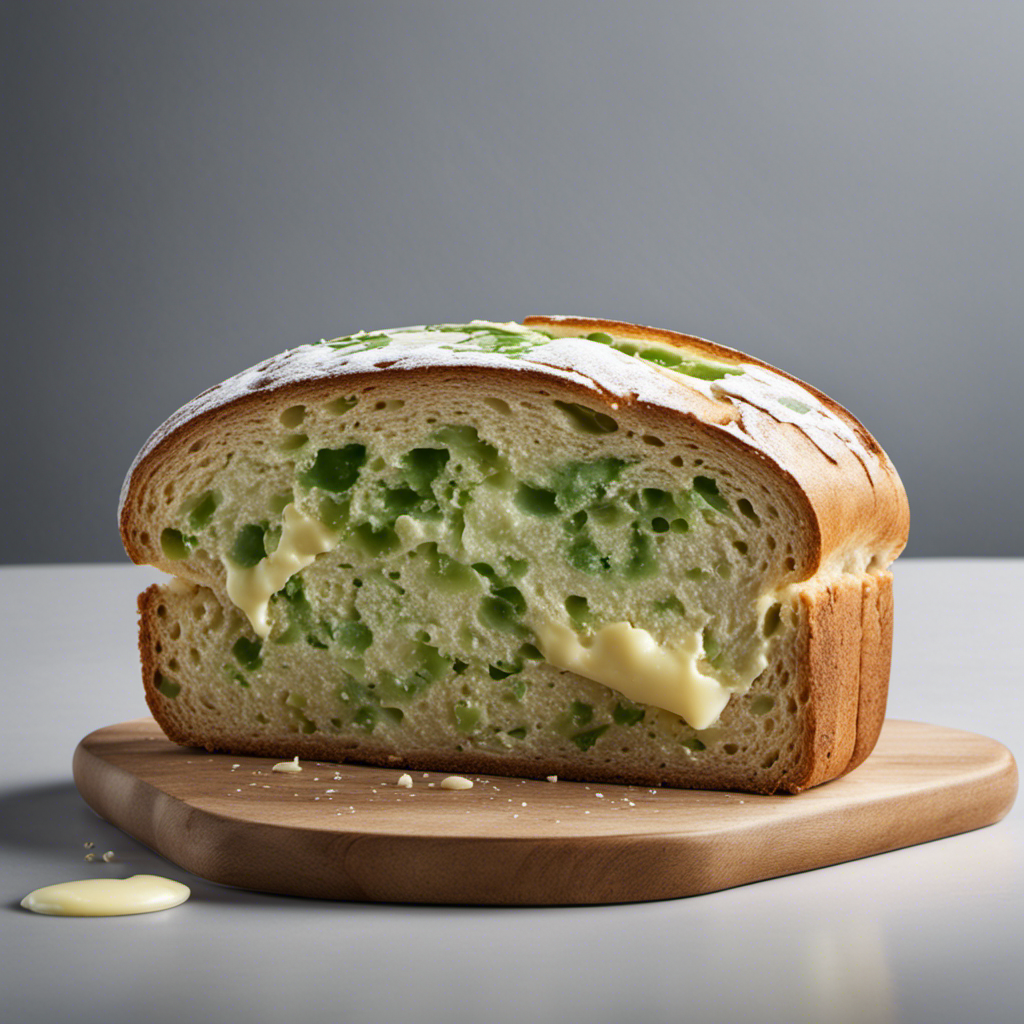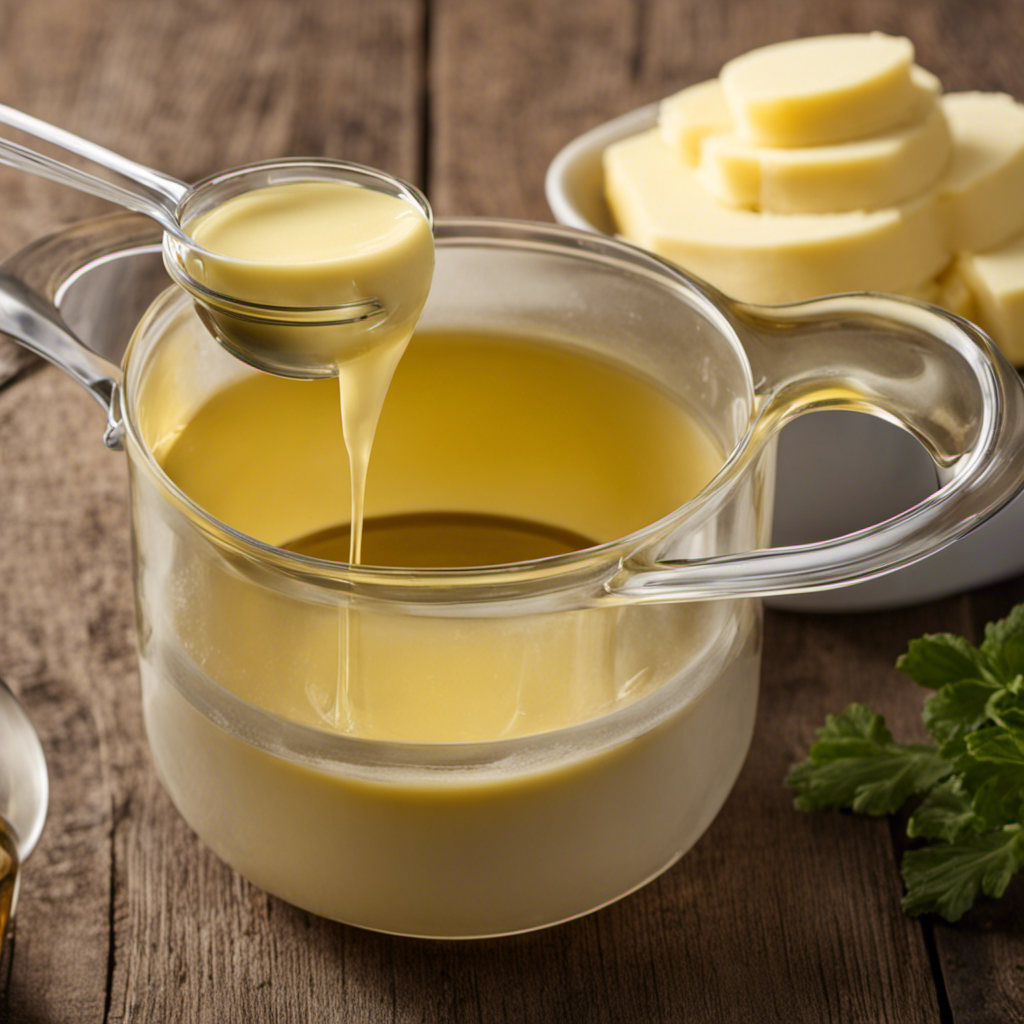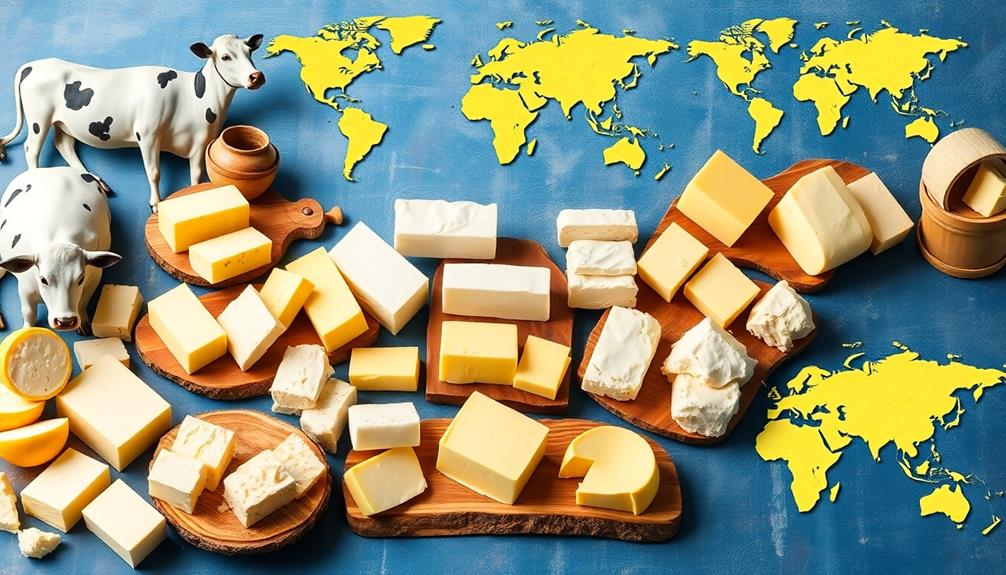Ah, the marvels of the Magic Butter Maker! Being someone who loves to cook at home, I’ve been captivated by this compact device that vows to transform regular butter into something genuinely enchanting.
But here’s the thing: figuring out how much butter to use can be a bit of a mystery. That’s why I’m here to guide you through the buttery journey, sharing tips, tricks, and a conversion chart that will help you avoid any butter-related disasters.
So, grab your apron and let’s dive into the world of butter with the Magic Butter Maker!
Key Takeaways
- The Magic Butter Maker requires a minimum of 1 stick of butter to work efficiently, but can accommodate up to 2 sticks for larger batches.
- Factors like desired potency and ingredients used can affect the infusion time, so it may be necessary to extend the infusion time by an additional hour if needed.
- It is important to ensure that all ingredients are finely ground or chopped for better infusion and to melt the butter if it doesn’t blend properly with other ingredients.
- Following the recommended butter to ingredient ratios specified in recipes and adjusting other ingredients accordingly will help achieve the desired texture and tenderness of the final product.
Understanding the Magic Butter Maker
To understand the Magic Butter Maker, you’ll need to know how many sticks of butter it requires. This innovative kitchen appliance is designed to infuse butter with herbs, flavors, and other ingredients, making it perfect for creating homemade infused butter for baking or cooking. The Magic Butter Maker requires a minimum of 1 stick of butter to work efficiently, but it can accommodate up to 2 sticks of butter for larger batches.
Calculating the infusion time is an important aspect of using the Magic Butter Maker. It typically takes around 2 hours to complete the infusion process. However, factors such as the desired potency and the type of ingredients used can affect the infusion time. For stronger flavors, you may choose to extend the infusion time by an additional hour or so.
Sometimes, during the infusion process, you may encounter troubleshooting issues. One common problem is the butter not blending properly with the other ingredients. In this case, make sure to melt the butter before adding it to the Magic Butter Maker. Additionally, ensure that all the ingredients are finely ground or chopped to promote better infusion.
Understanding the Magic Butter Maker and its requirements, as well as being aware of how to calculate infusion time and troubleshoot any issues that may arise, will help you make the most out of this versatile kitchen tool.
Butter Quantity for Different Recipes
For different recipes, you’ll need varying amounts of butter. Getting the right butter quantity is essential to ensure your dishes turn out delicious and balanced. Here are some helpful tips for butter quantity calculations and butter to ingredient ratios:
-
Follow the recipe: The first step is to carefully read the recipe and understand the required amount of butter. Recipes usually specify the quantity in measurements like tablespoons, cups, or grams. Make sure to follow these instructions precisely.
-
Consider the butter to ingredient ratio: Some recipes may require a specific butter to ingredient ratio. For example, in baking, the ratio of butter to flour affects the texture and tenderness of the final product. It’s important to adhere to these ratios to achieve the desired results.
-
Adjust for personal preference: While recipes provide guidelines, you can always adjust the butter quantity to suit your taste. If you prefer a richer flavor, you can increase the amount of butter slightly. Just be mindful of the recipe’s overall balance and adjust other ingredients accordingly.
Calculating the right amount of butter for different recipes may seem daunting at first, but with practice, you’ll become more confident in your butter quantity calculations. Remember, a little experimentation can lead to delightful culinary discoveries!
Calculating Butter Amounts
When calculating the amount of butter needed for your recipe, you’ll want to consider the specific butter to ingredient ratio. This is especially important when using a magic butter maker, as it helps in achieving the desired infusion strength. To make things easier, I’ve created a table below that shows the recommended ratios of butter to ingredients for different recipes:
| Recipe | Butter to Ingredient Ratio |
|---|---|
| Brownies | 1 stick of butter to 1 cup of flour, 1 cup of sugar, and 4 eggs |
| Cookies | 1 stick of butter to 2 cups of flour, 1 cup of sugar, and 2 eggs |
| Cake | 1 stick of butter to 2 cups of flour, 1 cup of sugar, and 3 eggs |
| Pancakes | 1 stick of butter to 1 cup of flour, 1 cup of milk, and 2 eggs |
| Pasta Sauce | 1 stick of butter to 1 can of tomato sauce and 1 teaspoon of herbs |
Butter Conversion Chart for Magic Butter Maker
The butter conversion chart in the recipe table provides recommended ratios for different recipes when using the magic butter maker. This chart is a helpful tool for anyone looking to infuse butter with various herbs or flavors.
Here are three key things to keep in mind when using the butter conversion chart:
-
Butter Infusion Techniques: The chart provides ratios for both infused and non-infused butter. Infused butter is when you add herbs or other ingredients to the butter to give it a unique flavor. Non-infused butter is simply regular butter without any additional flavors. The chart will guide you on how much butter to use for each technique.
-
Butter Potency Levels: The chart also takes into account the desired potency level of your infused butter. Depending on your preferences, you can choose to make mild, medium, or strong infused butter. The chart will tell you the recommended amount of herbs or ingredients to use for each potency level.
-
Recipe Specifics: The chart is divided into different recipes, ranging from sweet to savory. Whether you’re making brownies, cookies, or a delicious pasta dish, the chart will provide you with the appropriate butter ratios for each recipe.
Using the butter conversion chart will ensure that you achieve the perfect balance of flavors and potency in your infused butter.
Butter Ratios and Measurements
To determine the right amount of butter for your infused recipes, simply refer to the butter conversion chart and follow the recommended ratios. Butter infusion techniques require precision and careful measurement to achieve desired potency levels. Whether you’re making edibles or topicals, it’s important to understand the proper butter to herb ratio. This will ensure that your infused creations have the perfect balance of flavor and effect.
The butter conversion chart provides you with the necessary information to convert your recipe’s butter requirements to the appropriate amount of infused butter. It takes into account the potency of your chosen herb and provides guidelines for achieving different levels of potency.
When using the Magic Butter Maker, it’s crucial to follow these ratios to avoid overpowering or underwhelming results. The potency of your infused butter is determined by the amount of herb used in relation to the amount of butter. If you’re looking for a milder effect, you’ll want to use less herb per stick of butter. On the other hand, if you’re seeking a stronger potency, you’ll want to increase the amount of herb used.
Finding the Perfect Butter-to-Ingredient Ratio
When it comes to making infused butter, finding the optimal butter-to-ingredient ratio is key. In order to achieve the perfect infusion, it’s important to experiment with different ratios and ingredients.
Through trial and error, I’ve discovered that the ratio of butter to ingredients can greatly affect the potency and flavor of the final product.
Optimal Butter Infusion
For optimal butter infusion in your magic butter maker, you’ll want to use the recommended amount of butter sticks. This ensures that the infusion process is efficient and the flavors are properly infused into the butter. Here are three tips to help you achieve the best results:
-
Use high-quality butter: The quality of the butter you use will greatly affect the taste and texture of the infused butter. Look for butter that is made from high-quality cream and has a rich, creamy flavor.
-
Experiment with different infusion techniques: There are various techniques you can try to infuse your butter with different flavors. Some popular methods include using herbs and spices, adding fruits or vegetables, or even infusing with CBD or THC.
-
Consider the optimal infusion time: The length of time you infuse your butter will depend on the ingredients and flavors you are using. It’s best to start with a shorter infusion time and taste test along the way to ensure you achieve the desired flavor intensity.
Experimenting With Ingredient Ratios
Experimenting with different ingredient ratios can yield unique and delicious results in your infused butter. When it comes to butter infusion techniques, flavor experimentation is key. By adjusting the amounts of herbs, spices, or other flavorings, you can create a personalized butter infusion that suits your taste preferences. To give you an idea of the endless possibilities, here is a table showcasing three different ingredient ratios and the resulting flavors they produce:
| Ingredient Ratio | Flavor Profile |
|---|---|
| Equal Parts | Balanced |
| More Herb-Forward | Robust |
| Less Herb-Forward | Subtle |
As you can see, the ratios can greatly influence the taste of your infused butter. Don’t be afraid to get creative and try different combinations to find your perfect flavor. Now, let’s move on to adjusting butter amounts for desired potency.
Adjusting Butter Amounts for Desired Potency
To achieve the desired potency, you’ll need to adjust the amount of butter used in the magic butter maker. Here’s how you can maximize the butter infusion and adjust the potency to your liking:
-
Start with the recommended amount: The magic butter maker usually suggests using 2 to 5 sticks of butter, depending on the desired potency. If you’re unsure, it’s best to start with the minimum recommended amount and then adjust accordingly.
-
Increase the butter for stronger potency: If you want a more potent infusion, you can add extra sticks of butter to the magic butter maker. This will increase the concentration of cannabinoids in the final product, resulting in a stronger effect.
-
Decrease the butter for milder potency: On the other hand, if you prefer a milder potency, you can reduce the amount of butter used. This will result in a less concentrated infusion, making it suitable for those who are new to edibles or prefer a more subtle effect.
Tips for Using the Magic Butter Maker With Butter
Now that we’ve covered how to adjust the amount of butter for desired potency, let’s dive into some tips for using the Magic Butter Maker with butter.
Infusing butter is a fantastic way to add a rich cannabis flavor to your favorite recipes.
When it comes to butter infusion techniques, it’s important to start with the right ingredients. Use high-quality unsalted butter to achieve the best results. The Magic Butter Maker is designed to work with one to two sticks of butter, depending on your desired potency.
To ensure a consistent and smooth butter infusion, it’s crucial to troubleshoot any issues with the butter’s consistency. If your butter turns out too runny, it might be due to using a lower fat content butter. In this case, you can add a tablespoon of melted coconut oil to help thicken it up. On the other hand, if your butter is too thick, you can add a small amount of warm water to achieve the desired consistency.
Remember to follow the instructions provided with the Magic Butter Maker for optimal results.
With these tips in mind, you’ll be well on your way to creating delicious cannabis-infused butter for your culinary adventures.
Butter Recommendations for Infused Recipes
When it comes to infusing butter, finding the optimal balance is key.
In this discussion, I will delve into the art of butter infusion, sharing tips and guidelines to help you achieve the perfect infusion every time.
From the recommended quantity of butter to the best practices for infusion, prepare to elevate your culinary creations with the rich and flavorful essence of infused butter.
Optimal Butter Infusion
For optimal butter infusion in your magic butter maker, you’ll want to use the recommended amount of sticks of butter. This will ensure that the flavors of your infused butter are well-balanced and delicious. Here are three key tips to help you achieve the best results:
-
Choose the right butter infusion technique: There are several methods you can use to infuse butter, such as using a double boiler or a slow cooker. Each technique has its own advantages and can yield different flavor profiles, so choose the one that suits your preferences.
-
Experiment with different flavor profiles: Infused butter offers endless possibilities when it comes to flavor. You can add herbs like rosemary or thyme for a savory profile, or try adding vanilla or cinnamon for a sweet twist. Don’t be afraid to get creative and explore different combinations.
-
Strain your infused butter properly: To ensure a smooth and silky texture, it’s important to strain your infused butter after the infusion process. This will remove any solid particles or impurities, resulting in a more refined final product.
Butter Quantity Guidelines
To achieve the best results, it’s important to use the recommended amount of butter sticks for optimal infusion in your recipe. Measuring butter accurately is crucial for the potency and flavor of your infusion. Here are some handy butter quantity tips to help you get it right every time:
| Recipe Size | Butter Quantity |
|---|---|
| Small Batch | 1 stick |
| Medium Batch | 2 sticks |
| Large Batch | 3 sticks |
| Extra Large | 4 sticks |
| Party Size | 5 sticks |
These guidelines are based on the standard size of butter sticks, which is typically 1/2 cup or 1/4 pound. However, it’s always a good idea to check the measurements on the packaging of your butter to ensure accuracy. Remember, using the right amount of butter will ensure a perfectly infused recipe that is both flavorful and potent. Happy infusing!
Butter Dosage Guidelines for Different Strengths
You’ll want to know the butter dosage guidelines for different strengths. When it comes to making infused butter with the Magic Butter Maker, it’s important to understand the potency levels and adjust the butter ratios accordingly. Here are three key points to keep in mind:
-
Start with a lower potency: If you’re new to making infused butter, it’s best to begin with a lower potency level. This means using a smaller amount of cannabis per stick of butter. This way, you can gauge the effects and adjust the dosage to your liking.
-
Increase potency gradually: As you become more comfortable with the process, you can gradually increase the potency of your infused butter. This can be done by increasing the amount of cannabis per stick of butter or by using higher-potency strains.
-
Experiment and find your sweet spot: Everyone’s tolerance and preferences are different, so it’s important to experiment and find the dosage that works best for you. Start with a small amount and gradually increase until you achieve your desired effects.
By following these butter dosage guidelines for different strengths, you can enjoy the benefits of infused butter while finding the perfect balance for your needs.
Now, let’s explore how you can maximize butter efficiency with the Magic Butter Maker.
Maximizing Butter Efficiency With the Magic Butter Maker
To maximize your butter efficiency with the Magic Butter Maker, follow these simple steps. First, gather your ingredients – butter and your desired infusion materials such as herbs, spices, or even CBD. Next, set up your Magic Butter Maker by placing the stainless steel pitcher into the main unit and securing the lid. Plug it in and select your desired temperature and time settings.
Now, let’s talk about butter infusion techniques. The Magic Butter Maker is a versatile appliance that allows you to infuse butter with various flavors and ingredients. You can experiment with different combinations to create unique and delicious infusions. Whether you want to make herb-infused butter for cooking or CBD-infused butter for relaxation, the possibilities are endless.
To help you get started, here’s a handy table showcasing some popular butter infusion techniques:
| Infusion Technique | Ingredients | Temperature | Time |
|---|---|---|---|
| Herb-infused butter | Fresh herbs (e.g., rosemary, thyme) | 160°F | 2 hours |
| Spiced-infused butter | Spices (e.g., cinnamon, nutmeg) | 160°F | 1 hour |
| CBD-infused butter | CBD flower or oil | 160°F | 3 hours |
| Flavored-infused butter | Fruits (e.g., lemon zest, orange peel) | 160°F | 2 hours |
If you encounter any issues during the butter infusion process, here are some common butter infusion troubleshooting tips:
-
Insufficient flavor: If your infused butter lacks flavor, try increasing the amount of infusion materials or extending the infusion time slightly.
-
Separation: If your infused butter separates into layers, try using clarified butter or ghee instead. These types of butter have a higher fat content and are less prone to separation.
-
Burnt taste: If your infused butter has a burnt taste, make sure to monitor the temperature closely and avoid overheating the butter.
Avoiding Butter Waste With Proper Measurements
When it comes to cooking and baking, accurate butter measurements are crucial. Using too much or too little butter can significantly impact the texture and taste of your dish.
In this discussion, we will explore the importance of precise butter measurements, as well as techniques for preventing excess butter and minimizing waste.
Accurate Butter Measurements
For accurate butter measurements, it’s important to use a kitchen scale. Here are three reasons why:
-
Precise Calculations: Using a kitchen scale allows you to accurately measure the amount of butter needed for your recipe. This is especially crucial when calculating butter ratios in baking, where the right amount can make a significant difference in the final outcome.
-
Adjusting Butter Potency: Some recipes require a specific butter potency, such as when making cannabutter. By weighing the butter, you can easily adjust the potency by adding or reducing the amount of cannabis used. This ensures you have control over the strength of your infused butter.
-
Consistent Results: Measuring butter by weight provides consistent results each time you cook or bake. This consistency is vital in achieving the desired texture, taste, and overall quality of your dishes.
Preventing Excess Butter
Now that we know how to measure butter accurately for our Magic Butter Maker, let’s talk about butter portion control to prevent any overflow.
It’s important to remember that butter has a tendency to expand as it melts, so it’s crucial not to overfill the machine with butter. Start by using the recommended amount of butter for your recipe and avoid going overboard. If you’re unsure, it’s always better to err on the side of caution and use a little less butter than risking a messy overflow.
Additionally, make sure your Magic Butter Maker is properly sealed to prevent any leakage. By following these tips, you can ensure that your butter-making process goes smoothly without any mess or waste.
Speaking of minimizing butter waste, let’s move on to the next section.
Minimizing Butter Waste
To minimize waste, remember to seal your butter-making device properly and avoid using too much butter. Here are three techniques to help you reduce butter waste and conserve this precious ingredient:
-
Measure accurately: Use a kitchen scale or measuring cups to ensure you’re adding the right amount of ingredients. This will prevent any excess butter from going to waste.
-
Store properly: After making butter, store it in an airtight container or wrap it tightly in wax paper. This will keep it fresh and prevent it from spoiling, allowing you to use it all before it goes bad.
-
Plan ahead: Before making butter, think about how much you really need. By planning your recipes and portion sizes, you can avoid making more butter than necessary, reducing waste in the process.
Butter Experimentation: Finding Your Preferred Amount
You can try experimenting with different amounts of butter to find your preferred quantity for the magic butter maker. Finding the perfect consistency and experimenting with different flavors are essential when it comes to making delicious and creamy butter. The magic butter maker allows you to customize your butter to suit your taste preferences, and by varying the amount of butter you use, you can achieve different results.
To help you on your butter experimentation journey, I have created a handy table below that showcases the impact of different amounts of butter on the final product:
| Amount of Butter | Result |
|---|---|
| 1 stick | Light and spreadable |
| 2 sticks | Creamy and rich |
| 3 sticks | Extra creamy and decadent |
| 4 sticks | Ultra-rich and indulgent |
By using this table as a guide, you can adjust the amount of butter according to your desired consistency. Whether you prefer a lighter and spreadable butter or an indulgently rich one, the magic butter maker allows you to experiment and find your ideal quantity.
Butter Variations and Substitutions for the Magic Butter Maker
When it comes to using the Magic Butter Maker, there are a variety of butter alternatives to explore. Whether you’re looking for vegan options or healthier substitutes, there are plenty of choices to consider.
In this discussion, we’ll delve into the world of butter alternatives, exploring vegan butter options and healthier substitutes that can be used with the Magic Butter Maker.
Butter Alternatives for Magic Butter Maker
Butter alternatives like margarine or coconut oil are suitable for the Magic Butter Maker. Here are three options for those looking for butter alternatives for baking or dairy-free butter options for the Magic Butter Maker:
-
Margarine: Margarine is a popular butter substitute that has a similar texture and taste. It is made from vegetable oils and is dairy-free, making it a great option for those with lactose intolerance or on a vegan diet.
-
Coconut oil: Coconut oil is another excellent substitute for butter in the Magic Butter Maker. It adds a unique flavor and aroma to your baked goods and is also dairy-free. Coconut oil is solid at room temperature, making it a suitable replacement for butter in recipes.
-
Vegan butter: There are also several brands of vegan butter available in the market that work well in the Magic Butter Maker. These butter alternatives are made from plant-based oils and are specifically designed to mimic the taste and texture of traditional butter.
Now, let’s explore some vegan butter options for the Magic Butter Maker.
Vegan Butter Options
If you’re looking for vegan butter options, there are several brands available in the market that can be used in the Magic Butter Maker.
One popular brand is Earth Balance, which offers a variety of vegan buttery spreads and sticks. Their products are made from plant-based oils and are free from dairy, soy, and gluten.
Another great option is Miyoko’s Creamery, known for their artisanal vegan butter. They use a blend of nuts and oils to create a rich and creamy butter alternative.
For those who prefer homemade options, there are many delicious vegan butter recipes available online. These recipes often include ingredients like coconut oil, cashews, and nutritional yeast to achieve a buttery flavor and texture.
Whether you choose a store-bought brand or make your own, there are plenty of vegan butter options to enhance your cooking and baking in the Magic Butter Maker.
Healthier Butter Substitutes
When it comes to butter, many of us are looking for healthier alternatives. While traditional butter is delicious, it can be high in saturated fat. Luckily, there are several homemade butter recipes that offer health benefits without sacrificing taste.
Here are three options to consider:
-
Avocado Butter: Made from ripe avocados, this butter is rich in heart-healthy monounsaturated fats and packed with vitamins and minerals. It has a creamy texture and a mild, nutty flavor.
-
Coconut Oil Butter: Coconut oil is a popular choice for those seeking a dairy-free butter substitute. It is high in medium-chain triglycerides, which can boost metabolism and support brain health. This butter has a subtle coconut flavor.
-
Almond Butter: Almonds are a great source of healthy fats, protein, and fiber. Homemade almond butter is easy to make and offers a rich, nutty taste. It can be spread on toast, used in baking, or added to smoothies for added creaminess.
Try these homemade butter recipes for a healthier twist on your favorite spreads and enjoy the health benefits they provide.
Troubleshooting Butter Amounts in the Magic Butter Maker
To troubleshoot the amount of butter needed in the Magic Butter Maker, you can adjust the recipe accordingly. The Magic Butter Maker is a fantastic tool for infusing butter with herbs, spices, or other flavors. However, sometimes you may find that the butter comes out too strong or too weak. This can be easily fixed by following a few simple steps.
First, let’s take a look at a table that shows the recommended amount of butter for different infusion strengths:
| Infusion Strength | Butter Amount (sticks) |
|---|---|
| Mild | 1 |
| Medium | 2 |
| Strong | 3 |
| Extra Strong | 4 |
| Intense | 5 |
By referring to this table, you can determine how many sticks of butter to use based on the desired infusion strength. If you find that your butter is too weak, simply increase the amount of butter used. On the other hand, if the flavor is too strong, decrease the amount of butter.
Frequently Asked Questions
How Long Does It Take to Make Butter in the Magic Butter Maker?
It takes about 2 hours to make butter in the Magic Butter Maker. First, melt the butter in the machine, then let it infuse with herbs or flavors. Finally, strain and refrigerate for delicious homemade butter.
Can I Use Margarine Instead of Butter in the Magic Butter Maker?
Sure, you can use margarine as an alternative to butter in the Magic Butter Maker. However, keep in mind that the taste and texture may differ slightly. Experiment to find your preferred choice.
Are There Any Specific Types of Butter That Work Best With the Magic Butter Maker?
Different flavors of butter for the magic butter maker include salted, unsalted, and even flavored varieties like garlic or herb. To make the perfect butter, ensure the butter is softened and follow the instructions carefully.
How Do I Adjust the Butter Amount for a Smaller or Larger Batch?
To adjust the butter amount for a smaller or larger batch, simply halve or double the amount of butter. Alternatively, you can try using alternative ingredients like coconut oil or margarine for a different flavor profile.
Can I Use Clarified Butter in the Magic Butter Maker?
I can use clarified butter in the Magic Butter Maker. It has a higher smoke point and a longer shelf life. Different types of butter can enhance the flavor and texture of the final product.
Conclusion
As I reach the end of this buttery journey, I am reminded of a symphony of flavors, dancing in perfect harmony.
Like a conductor, the Magic Butter Maker orchestrates the creation of delectable delights. And just like a maestro, it requires the right amount of butter to create the perfect composition.
With the help of the Butter Conversion Chart, we can measure with precision, ensuring no butter goes to waste.
So go forth, fellow adventurers, and explore the realms of butter experimentation, for the Magic Butter Maker awaits your culinary creativity!










